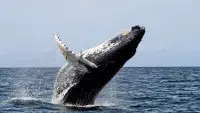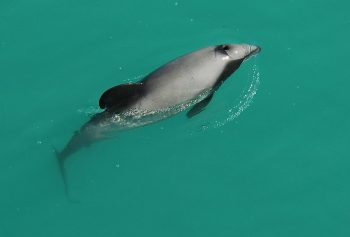Humpback whale (Megaptera Novaeangliae) is one of the 15 species of baleen whale. Humpbacks are famous for their beautiful magical songs. They emit a series of howls and moans that can go on for hours. Humpbacks are powerful swimmers and highly migratory species. Normally, they travel long distances and cover about 16,000 miles every year. Humpbacks are usually solitary animals but may also form pods (group name) of 10 to 15 individuals.
Humpbacks have stubby body and prominent hump. The upper body is bluish-black in color while it is white from beneath. They have long pectoral fins. The head is unique because it is covered with knobs known as tubercles. The white flippers are the world’s largest for any animal and measures up to 16 feet in length. There are up to 36 throat grooves on the mouth’s lower side.
A female humpback has a size range of 49 to 62.5 feet in length. Males are slightly shorter than the female whales. The adult humpbacks weigh up to 88,000 pounds. The width of its tail is 18 feet.
The lifespan of  a humpback whale is more than 48 years.
a humpback whale is more than 48 years.
A female humpback matures at 5 years of age while males reach maturity at the age of 7 years.
A newborn calf has a length of 20 feet. The mother suckles her offspring for 6 months. The calf stays with its mother for about 12 months and becomes an adult at the age of 10. A female gives birth to single calf after every 2 to 3 years.
Humpbacks are found in all of the world’s major oceans. Globally, they are present in the Antarctic, North Pacific, Indian and the Atlantic Oceans. In 1991, a humpback whale appeared off the coast of Australia. It was all white in color. It was named ‘Albino’ meaning ‘white fella’.
Humpbacks are omnivores. They like to eat tiny organisms like krill and plankton in summer. Apart from this, other small fish include herring, Sand Lance, Boston Blue, Boston mackerel, Pacific Salmon, caplin and haddock.
Today, the likely threats are the bumping of these whales into fishing gear and ships. Besides, noise pollution also plays a damaging role in the killing of humpbacks.
Orcas are the predators of juvenile humpbacks. Besides, humans have also killed about 200,000 humpback whales in commercial whaling during the twentieth century alone, wiping out 90 percent of its population.





